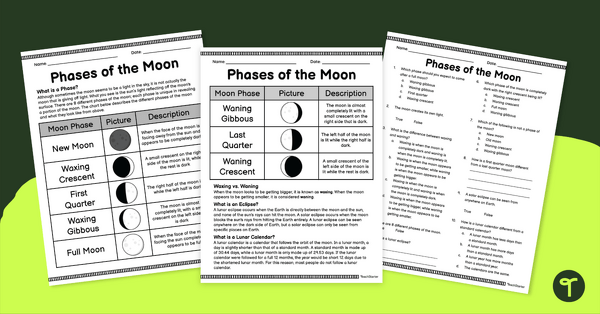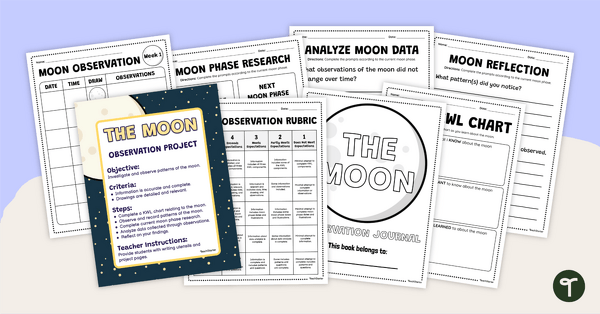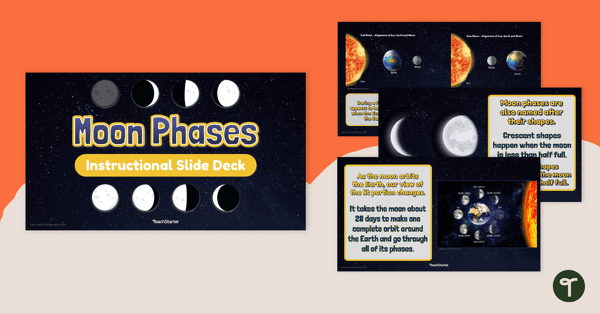Phases of the Moon Teaching Resources
Bring moon phases into the classroom with printable worksheets, digital activities, and more that help students visualize the phases of the moon during the school day!
This collection of NGSS curriculum-aligned teaching resources has been teacher-created to help you save time on your lesson planning so you can spend more time doing what you really love — engaging your students.
Inside you'll find snacktivities that turn delicious cookies into a hands-on moon phases lesson, vocabulary and game cards, and so much more.
These moon-themed teaching resources are editable too, so you can easily differentiate instruction for your individual learners and make any necessary changes to meet your individual state standards.
New to teaching this part of the science curriculum? Take off for the moon with our teacher team in this quick primer, including a definition to explain the meaning of the phases of the moon, plus ways to teach kids about waxing and waning and plenty more!
What Are Moon Phases? A Kid-Friendly Definition
First thing's first! Our teacher team has a handy definition you can use to introduce your class to the moon and its phases.
The term "moon phases" refers to the moon's changing appearance as it orbits around the Earth. The Moon's phase at any given time is determined by the relative positions of the Sun, Earth, and Moon.
As the Moon orbits around the Earth, the amount of sunlight reflecting off its surface changes. This makes it appear to change shape (although it's simply a reflection!). These different shapes or appearances of the Moon are what we describe as the moon phases.
Throughout human history, we've used these phases of the moon for everything from navigation to tracking time. Some teachers even say they can tell when their classes are going to be a bit more rowdy based on the phase of the moon!
How Many Phases of the Moon Are There?
There are 8 different phases of the Moon to walk your students through, and their names are packed with vocabulary such as "waxing" and "waning" that they'll be learning during your Moon unit.
Why so many? This comes down to the exact way the Moon orbits around the Earth, but that's only half of the equation. The phase of the Moon is also affected by the way that both the Earth and the Moon orbit around the Sun.
The Moon orbits the Earth, completing one orbit in approximately 27.3 days. As the Moon orbits the Earth, the angle between the Sun, Earth, and Moon changes, and that means the amount of sunlight that reflects off the Moon and reaches Earth varies too. This causes the appearance of the Moon as viewed from Earth to change, resulting in — you guessed it — the eight different phases of the Moon.
What Are the Phases of the Moon?
We already said there are eight different phases, so let's dig deeper. Here are the phases in order of when they're seen by humans:
- New Moon
- Waxing Crescent
- First Quarter
- Waxing Gibbous
- Full Moon
- Waning Gibbous
- Third Quarter
- Waning Crescent
The New Moon phase occurs at the beginning of a new lunar cycle, and it is not visible from Earth because the side of the Moon facing the Earth is not illuminated by the Sun. The Full Moon is seen here on Earth in the middle of the lunar cycle and appears as a fully illuminated disc.

Watch the moon as it goes through its phases!
What Is the Moon Phases Calendar?
Although humans use the Gregorian calendar (sometimes called the New Style calendar) to determine the length of a typical year and month, the Moon doesn't exactly follow along with humankind.
The celestial body has its own calendar of sorts, and a month of moon phases — essentially the time it takes for the Moon to complete one full cycle of phases — is just 29.5 days. This is known as a lunar month or a synodic month.
Waxing Moon vs. Waning Moon
One final word on the world's nightlight! Students often get caught up in understanding what it means when a moon is waning and when it's waxing.
The difference between the two has to do with the amount of sunlight that is visible on the Moon's surface as viewed from Earth.
Here's how to break them down so your students can understand them:
Waxing Moon
This is a Moon that appears to be getting bigger and brighter as it moves from a New Moon towards a Full Moon. During the waxing moon phase, the amount of sunlight that reflects off the Moon and reaches Earth increases, so the visible portion of the Moon's surface is slowly growing.
The Waxing Moon can be divided into four phases:
- New Moon
- Waxing Crescent
- First Quarter
- Waxing Gibbous
Waning Moon
Essentially the opposite of a waxing Moon, the waning Moon is one that appears to be getting smaller and dimmer as it moves from a Full Moon towards a New Moon. During this moon phase, the amount of sunlight that reflects off the Moon and reaches Earth decreases, so the visible portion of the Moon's surface is gradually shrinking.
The Waning Moon can also be divided into four phases:
- Waning Gibbous
- Last Quarter
- Waning Crescent
- New Moon
- Free Plan

Phases of the Moon – Comprehension Worksheet
Analyze different moon phases and how their visual appearances change over time with this reading comprehension worksheet.
- Free Plan

Phases of the Moon – Worksheet
Label the phases of the moon as they appear in the northern hemisphere with this printable science worksheet.
- Free Plan

Moon Phases – Cut and Paste Activity
Create a diagram showing the different moon phases and their names with this cut-and-paste activity sheet.
- Plus Plan

The Moon – Reading Passage and Response Sheet
Engage your students with a high-interest reading passage about the moon with this informative article and accompanying response sheet.
- Plus Plan

Moon Facts Writing Template
Describe and illustrate information about the moon with a printable writing template.
- Plus Plan

Phases of the Moon – Journal Project
Observe, describe, and record patterns of the lunar cycle with this moon tracking project.
- Plus Plan

Moon Phases – Poster Set
Learn about the lunar cycle with this this set of posters showing the different phases of the moon.
- Plus Plan

Moon Phases Diagram
Learn about the position of the moon and its phases as it orbits the Earth with this illustrated diagram.
- Plus Plan

Snapshots of the Moon – Moon Tracking Booklet
Obverse the moon over the course of the month and chart observations with this moon phases mini-book.
- Plus Plan

Moon Phases – Instructional Slide Deck
Learn about the different phases of the moon and how its appearance changes over time with this instructional slide deck.
- Plus Plan

Phases of the Moon Bulletin Board Kit
Display information about the phases of this moon with an out-of-this-world bulletin board display.
- Plus Plan

Oreo® Moon Phases Worksheet
Engage your students with a science snack-tivity by completing this Oreo® moon phases worksheet.
- Plus Plan

Phases of the Moon – Data Worksheet
Use data to identify and predict when different phases of the moon are visible with this worksheet.
- Plus Plan

Phases of the Moon Activity - Task Cards
Review information about the different moon phases with this set of 24 Phases of the Moon Activity cards.
- Plus Plan

Moon Phases – Vocabulary Cards
Reinforce science vocabulary with a set of 15 vocabulary cards covering the different phases of the moon and related terms.
- Plus Plan

Moon Phases Tic-Tac-Toe (Small Group)
Identify and remember the different phases of the moon with this small group tic-tac-toe game.
- Plus Plan

Moon Phases Mini-Book
Read, learn, and complete comprehension exercises while studying the 8 moon phases.
